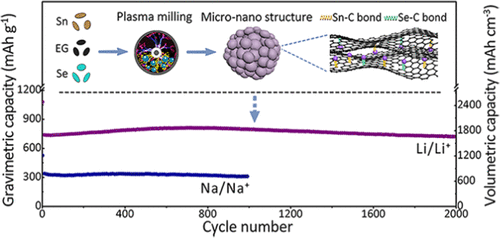当前位置:
X-MOL 学术
›
ACS Appl. Mater. Interfaces
›
论文详情
Our official English website, www.x-mol.net, welcomes your
feedback! (Note: you will need to create a separate account there.)
Sn–C and Se–C Co-Bonding SnSe/Few-Layered Graphene Micro–Nano Structure: Route to a Densely Compacted and Durable Anode for Lithium/Sodium-Ion Batteries
ACS Applied Materials & Interfaces ( IF 8.3 ) Pub Date : 2019-09-30 , DOI: 10.1021/acsami.9b12204 Deliang Cheng , Lichun Yang , Renzong Hu , Jiangwen Liu , Renchao Che 1 , Jie Cui , Yanan Wu , Wanyu Chen , Jianling Huang , Min Zhu , Yu-Jun Zhao
ACS Applied Materials & Interfaces ( IF 8.3 ) Pub Date : 2019-09-30 , DOI: 10.1021/acsami.9b12204 Deliang Cheng , Lichun Yang , Renzong Hu , Jiangwen Liu , Renchao Che 1 , Jie Cui , Yanan Wu , Wanyu Chen , Jianling Huang , Min Zhu , Yu-Jun Zhao
Affiliation

|
Developing anodes with a high and stable energy density for both gravimetric and volumetric storage is vital for high-performance lithium/sodium-ion batteries. Herein, an SnSe/few-layered graphene (FLG) composite with a high tap density (2.3 g cm–3) is synthesized via the plasma-milling method, in which SnSe nanoparticles are strongly bound with the FLG matrix, owing to both Sn–C and Se–C bonds, to form nanosized primary particles and then assemble to microsized secondary granules. The FLG can effectively alleviate the large stress generated from the volume expansion of SnSe during cycling based on its superstrength. Furthermore, as demonstrated by the density-functional theory calculations, the Sn–C and Se–C co-bonding benefitting from the formation of substantial vacancy defects on the P-milling-synthesized FLG enables strong affinity between SnSe nanoparticles and the FLG matrix, preventing SnSe from aggregating and detaching even after long-term cycling. As an anode for lithium-ion batteries, it exhibits high gravimetric and volumetric capacities (864.8 mAh g–1 and 1990 mAh cm–3 at 0.2 A g–1), a high rate (612.6 mAh g–1 even at 5.0 A g–1), and the longest life among the reported SnSe-based anodes (capacity retention of 92.8% after 2000 cycles at 1.0 A g–1). Subsequently, an impressive cyclic life (capacity retention of 91.6% after 1000 cycles at 1.0 A g–1) is also achieved for sodium-ion batteries. Therefore, the SnSe/FLG composite is a promising anode for high-performance lithium/sodium-ion batteries.
中文翻译:

Sn-C和Se-C共键合SnSe /很少层石墨烯微纳米结构:通往锂/钠离子电池致密且耐用的阳极
开发用于重力存储和体积存储的具有高且稳定能量密度的阳极对于高性能锂/钠离子电池至关重要。本文中,具有高振实密度(2.3 g cm –3的SnSe /几层石墨烯(FLG)复合材料)是通过等离子研磨法合成的,其中SnSe纳米颗粒由于Sn–C和Se–C键而牢固地与FLG基质结合,形成纳米级的初级颗粒,然后组装成微米级的次级颗粒。FLG基于其超强强度,可以有效缓解骑行过程中SnSe的体积膨胀所产生的大应力。此外,正如密度泛函理论计算所证明的那样,SnC和SeC的共键合受益于P铣削合成的FLG上大量空位缺陷的形成,从而使SnSe纳米颗粒与FLG基质之间具有很强的亲和力,即使长时间循环,也可以防止SnSe聚集和脱离。作为锂离子电池的阳极,它具有很高的重量和体积容量(864.8 mAh g –1和1990毫安厘米-3,在0.2 A克-1),以高速率(612.6毫安克-1甚至在5.0 A G -1),和之间的最长的使用寿命报告基于位SnSe-阳极(92.8%容量保持后在1.0 A g –1的条件下进行2000次循环。随后,钠离子电池还获得了令人印象深刻的循环寿命(在1.0 A g –1的条件下进行1000次循环后的容量保持率为91.6%)。因此,SnSe / FLG复合材料是高性能锂/钠离子电池的理想阳极。
更新日期:2019-09-30
中文翻译:

Sn-C和Se-C共键合SnSe /很少层石墨烯微纳米结构:通往锂/钠离子电池致密且耐用的阳极
开发用于重力存储和体积存储的具有高且稳定能量密度的阳极对于高性能锂/钠离子电池至关重要。本文中,具有高振实密度(2.3 g cm –3的SnSe /几层石墨烯(FLG)复合材料)是通过等离子研磨法合成的,其中SnSe纳米颗粒由于Sn–C和Se–C键而牢固地与FLG基质结合,形成纳米级的初级颗粒,然后组装成微米级的次级颗粒。FLG基于其超强强度,可以有效缓解骑行过程中SnSe的体积膨胀所产生的大应力。此外,正如密度泛函理论计算所证明的那样,SnC和SeC的共键合受益于P铣削合成的FLG上大量空位缺陷的形成,从而使SnSe纳米颗粒与FLG基质之间具有很强的亲和力,即使长时间循环,也可以防止SnSe聚集和脱离。作为锂离子电池的阳极,它具有很高的重量和体积容量(864.8 mAh g –1和1990毫安厘米-3,在0.2 A克-1),以高速率(612.6毫安克-1甚至在5.0 A G -1),和之间的最长的使用寿命报告基于位SnSe-阳极(92.8%容量保持后在1.0 A g –1的条件下进行2000次循环。随后,钠离子电池还获得了令人印象深刻的循环寿命(在1.0 A g –1的条件下进行1000次循环后的容量保持率为91.6%)。因此,SnSe / FLG复合材料是高性能锂/钠离子电池的理想阳极。


















































 京公网安备 11010802027423号
京公网安备 11010802027423号